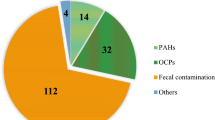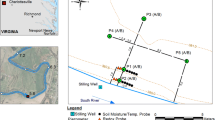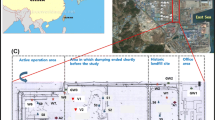Abstract
Since the early 1980s, investigations by health departments of eight counties in southern New Jersey, by the NJ Department of Environmental Protection (NJDEP), and subsequently by the US Geological Survey (USGS), have shown that Hg concentrations in water tapped by about 600 domestic wells exceed the maximum contaminant level (MCL) of 2 μg/L. The wells are finished in the areally extensive unconfined Kirkwood-Cohansey aquifer system of New Jersey's Coastal Plain; background concentrations of Hg in water from this system are < 0.01 μg/L. Evidence of contributions from point sources of Hg, such as landfills or commercial and industrial hazardous-waste sites, is lacking. During 1996–2003, the USGS collected water samples from 203 domestic, irrigation, observation, and production wells using ultraclean techniques; septage, leach-field effluent, soils, and aquifer sediments also were sampled. Elevated concentrations of NH4, B, Cl, NO3, and Na and presence of surfactants in domestic-well water indicate that septic-system effluent can affect water quality in unsewered residential areas, but neither septage nor effluent appears to be a major Hg source. Detections of hydrogen sulfide in ground water at a residential area indicate localized reducing conditions; undetectable SO4 concentrations in water from other residential areas indicate that reducing conditions, which could be conducive to Hg methylation, may be common locally. Volatile organic compounds (VOCs), mostly chlorinated solvents, also are found in ground water at the affected areas, but statistically significant associations between presence of Hg and VOCs were absent for most areas evaluated. Hg concentrations are lower in some filtered water samples than in paired unfiltered samples, likely indicating that some Hg is associated with particles or colloids. The source of colloids may be soils, which, when undisturbed, contain higher concentrations of Hg than do disturbed soils and aquifer sediments. Soil disturbance during residential development and inputs from septic systems are hypothesized to mobilize Hg from soils to ground water.
Similar content being viewed by others
References
Almeida, M. D., Lacerda, L. D., Bastos, W. R., & Herrmann, J. C. (2005). Mercury loss from soils following conversion from forest to pasture in Rondonia, western Amazon, Brazil. Environment Pollution, 137, 179–186.
Andersson, A. (1979). Mercury in soils. In J. Nriagu (Ed.) The biogeochemistry of mercury in the environment (pp. 79–112). Amsterdam, The Netherlands: Elsevier/North Holland Biomedical Press.
Andren, A. W., & Nriagu, J. O. (1979). The global cycle of mercury. In J. Nriagu (Ed.), The biogeochemistry of mercury in the environment (pp. 1–21). Amsterdam, The Netherlands: Elsevier/North Holland Biomedical Press.
Babiarz, C. L., Hoffman, S. R., Shafer, M. M., Hurley, J. P., Andren, A. W., & Armstrong, D. E. (2000). A critical evaluation of tangential-flow ultrafiltration for trace metal studies in freshwater systems. 2. Total mercury and methylmercury. Environmental Science Technololgy, 34, 3428–3434.
Babiarz, C. L., Hurley, J. P., Hoffman, S. R., Andren, A. W., Shafer, M. M., & Armstrong, D. E. (2001). Partitioning of total mercury and methylmercury to the colloidal phase in fresh waters. Environmental Science Technololgy, 35, 4773–4782.
Barber L., & Steele K. F. (1980). Mercury content of waters in the midcontinent region. Arkansas Academy of Science Proceedings, 34, 19–21.
Barkay, T., Gillman, M., & Turner, R. R. (1997). Effects of dissolved organic carbon and salinity on bioavailability of mercury. Applied and Environmental Microbiology, 63, 4267–4271.
Barringer, J. L., Szabo, Z., Kauffman, L. J., Barringer, T. H., Stackelberg, P. E., Ivahnenko, T., Rajagopalan, S., & Krabbenhoft, D. P. (2005). Mercury concentrations in water from an unconfined aquifer system, New Jersey Coastal Plain. Science of the Total Environment, 346, 169–183.
Barringer, J. L., Szabo, Z., Schneider, D., Atkinson, W. D., & Gallagher, R. A. (2006) Mercury in ground water, septage, leach-field effluent, and soils in residential areas, New Jersey coastal plain. Science of the Total Environment, 361, 144-162.
Barringer, J. L., & MacLeod, C. L. (2001). Relation of mercury to other chemical constituents in ground water in the Kirkwood-Cohansey aquifer system, New Jersey Coastal Plain, and mechanisms for mobilization of mercury from sediments to ground water. U. S. Geological Survey Water-Resources Investigations Report 95-4230.
Barringer, J. L., Szabo, Z., & Barringer, T. H. (1998). Arsenic and metals in soils in the vicinity of the Imperial Oil Company Superfund site, Marlboro Township, Monmouth County, New Jersey. U. S. Geological Survey Water-Resources Investigations Report 98-4016.
Barringer, J. L., MacLeod, C. L., & Gallagher, R. A. (1997). Mercury in ground water, soils, and sediments of the Kirkwood-Cohansey aquifer system in the New Jersey Coastal Plain. U. S. Geological Survey Open-File Report 95-475.
Barringer, J. L., & Ulery, R. L. (1988). Spatial relations of chloride and sulfate in shallow ground water to selected geographic features in the New Jersey Coastal Plain. EOS, Transations of the American Geophysical Union, 69, 347.
Benoit, J. M., Gilmour, C. C., Mason, R. P., & Heyes, A. (1999). Sulfide controls on mercury speciation and bioavailability to methylating bacteria in sediment pore waters. Environmental of the Science Technololgy, 33, 951–957.
Brenton, R. W., & Arnett, T. L. (1993). Methods of analysis by the U. S. Geological Survey National Water Quality Laboratory—Determination of dissolved organic carbon by UV-promoted persulfate oxidation and infrared spectrometry. U. S. Geological Survey Open-File Report 92-480.
Burkhardt. M. R., Cinotto. P. J., Frahm. G. W., Woodworth .M. T., & Pritt. J. W. (1995). Methods of analysis by the U. S. Geological Survey National Water Quality Laboratory—Determination of methylene blue active substances by spectrophotometry. U.S. Geological Survey Open-File Report 95-1189.
Clesceri, L. S., Greenberg, A. E., & Eaton, A. D. (eds.) (1998). Method 4500-5.2—sulfide. Standard methods for analysis of water and wastewater (20th ed.). Denver, CO: Amer. Public Health Assoc.
Cline, J. D. (1969). Spectrophotometric determination of hydrogen sulfide in natural waters. Limnology and Oceanography, 14, 454–458.
Deluca, M. J., Hoppe, H. L., Heckathorn, H. A., Riskin, M. L., Gray, B. J., Melvin, E. L., & Liu, N. A. (2003). Water Resources Data, New Jersey, Water Year 2003. U. S. Geological Survey Water-Data Report NJ-03-3.
Deluca, M. J., Heckathorn, H. A., Lewis, J. M., Gray, B. J., Melvin, E. L., Riskin, M. L., & Liu, N. A. (2004). Water Resources Data, New Jersey, Water Year 2004. U. S. Geological Survey Water-Data Report NJ-04-3.
Dooley, J. H. (1992). Natural sources of mercury in the Kirkwood-Cohansey aquifer system of the New Jersey Coastal Plain. N. J. Geological Survey Report 27.
Douglas, L. A., & Trela, J. J. (1979). Mineralogy of Pine Barrens soils. In Forman, R. T. T. (ed.). Pine Barrens: Ecosystem and landscape (pp. 81–93). NY: Academic Press.
Dreher, G. B., & Follmer, L. R. (2004). Mercury content of Illinois soils. Water, Air, Soil Pollution, 156, 299–315.
El-Farhan, Y. H., Denovio, N. M., Herman, J. S., & Hornberger, G. M. (2000). Mobilization and transport of soil particles during infiltration experiments in an agricultural field, Shenandoah Valley, Virginia. Environmental Science Technololgy, 34, 3555–3559.
Faires L. M. (1993). Methods of analysis by the U. S. Geological Survey National Water Quality Laboratory—Determination of metals in water by inductively coupled plasma-mass spectrometry. U. S. Geological Survey Open-File Report 92-634.
Federal Register (1999). EPA Method 1631. Federal Register, 64, 30417.
Fischer, P., & Gustin, M. S. (2002). Influence of natural sources on mercury in water sediment and aquatic biota in seven tributary streams of the East Fork of the Upper Carson River, California. Water, Air, Soil Pollution, 133, 283–295.
Fishman M. J. (1993). Methods of analysis by the U. S. Geological Survey National Water Quality Laboratory—Determination of inorganic and organic constituents in water and fluvial sediments. U. S. Geological Survey Open-File Report 93-125
Fishman, M. J., & Friedman, L. C. (1989). Methods for determination of inorganic substances in water and fluvial sediments. U. S. Geological Survey Techniques of Water-Resources Investigations, 5, A1.
Garbarino, J. R., & Damrau, D. L. (2001). Methods of analysis by the U. S. Geological Survey National Water Quality Laboratory—Determination of organic plus inorganic mercury in filtered and unfiltered natural water with cold vapor—atomic fluorescence spectrometry. U. S. Geological Survey Water-Resources Investigations Report 01-4132.
Gilmour, C. C., & Henry, E. A. (1991). Mercury methylation in aquatic systems affected by acid deposition. Environmental Pollution, 71, 131–169.
Gilmour, C. C., Henry, E. A., & Mitchell, R. (1992). Sulfate stimulation of mercury methylation in freshwater sediments. Environmental Science Technololgy, 26, 2281–2287.
Grigal, D. F. (2000). Inputs and outputs of mercury from terrestrial watersheds: a review. Environmental Review, 10, 1–39.
Grigal, D. F. (2003). Mercury sequestration in forests and peatlands. Journal of Environmental Quality, 32, 393–405.
Guimaraes, J. R. D., Ikingura, J., & Akagi, H. (2000). Methyl mercury production and distribution in river water-sediment systems investigated through radiochemical techniques. Water, Air, Soil Pollution, 124, 113–124.
Haitzer, M., Aiken, G. R., & Ryan, J. N. (2003). Binding of mercury (II) to aquatic humic substances: Influence of pH and source of humic substances. Environmental Science Technololgy, 37, 2436–2441.
Hammerschmidt, C. R., & Fitzgerald, W. F. (2004). Geochemical controls on the production and distribution of methylmercury in near-shore marine sediments. Environmental Science Technololgy, 38, 1487–1495.
Hogg, T. J., Stewart, J. W. B., & Bettany, J. R. (1978). Influence of the chemical forms of mercury on its adsorption and ability to leach through soils. Journal of Environment Quality, 7, 440–444.
Ivahnenko, T., Szabo, Z., & Gibs, J. (2001). Changes in sample collection and analytical techniques and effects on retrospective comparability of low-level concentrations of trace elements in ground water. Water Research, 35, 3517–3531.
Jay, J. A., Morel, F. M. M., & Hemond, H. F. (2000). Mercury speciation in the presence of polysulfides. Environmental Science Technololgy, 34, 2196–2200.
Kaplan, D. I., Bertsch, P. M., Adriano, D. C., & Miller, W. P. (1993). Soil-borne mobile colloids as influenced by water flow and organic carbon. Environmental Science Technololgy, 27, 1193–2000.
Krabbenhoft, D. P., & Babiarz, C. L. (1992). The role of groundwater transport in aquatic mercury cycling. Water Research, 28, 3119–3128.
Kroenke, A. E., Shuster, E. L., & Bopp, R. F. (2002). Assessment of historical and current trends in mercury deposition to New Jersey aquatic systems through analysis of sediment/soil cores. Final report to NJDEP, Division of Science and Research, Trenton, NJ. Rensselaer Polytechnic Institute, Troy, NY.
LeBlanc, D. R. (1984). Sewage plume in a sand and gravel aquifer, Cape Cod, Massachusetts. U. S. Geological Survey Water-Supply Paper 2218.
Macfarlane, P. A., Whittemore, D. O., Townsend, M. A., Butler, J. J., Jr, Doveton, J. H., Hamilton, V. J., Coleman, J., Chu, T. M., & Wade, A. (1990). The Dakota Aquifer program: Annual report, FY90. Kansas Geological Survey Open-File Report 91-1.
Marvin-DiPasquale, M. (2002). Partitioning of mercury to the colloidal phase in fresh waters. In Proceedings and Summary Report, Workshop on the fate, transport, and transformation of Hg in aquatic and terrestrial environments. West Palm Beach, FL, USA, EPA/625/R-02/005, 2001, B43.
Matilainen, T., Verta, M., Korhonen, H., Uusi-Rauva, A., & Niemi, M. (2001). Behavior of mercury in soil profiles: impact of increased precipitation, acidity, and fertilization on mercury methylation. Water, Air, Soil Pollution, 125, 105–119.
McCarthy, J. F., & McKay, L. D. (2003). Colloid transport in the subsurface: Past, present and future challenges. Vadose Zone J., 3, 1–12.
Murphy, E., Dooley, J., Windom, H. L., & Smith, Jr., R. G. (1994). Mercury species in potable ground water in southern New Jersey. Water, Air, Soil Pollution, 78, 61–72.
Murphy, E. A., & Aucott, M. (1999). A methodology to assess the amounts of pesticidal mercury used historically in New Jersey. Journal of Soil. Contamination, 8, 131–148.
Niebla, E. E., Korte, N. E., Alesii, B. A., & Fuller, W. H. (1976). Effect of municipal landfill leachate on mercury movement through soils. Water, Air, Soil Pollution, 5, 399–401.
Olson, M. L., & DeWild, J. F. (1999). Techniques for the collection and species-specific analysis of low levels of mercury in water, sediment, and biota. U. S. Geological Survey Water-Resources Investigations Report 99-4018.
Patton, C. J., & Truitt, E. P. (1992). Methods of analysis by the U. S. Geological Survey National Water Quality Laboratory—Determination of total phosphorus by a Kjeldahl disgestion method and an automated colorimentric finish that includes dialysis. U. S. Geological Survey Open-File Report 92-146.
Porvari, P., Verta, M., Munthe, J., & Haapanen, M. (2003). Forestry practices increase mercury and methyl mercury output from boreal forest catchments. Environmental Science Technololgy, 37, 2389–2393.
Ptacek, C. J. (1998). Geochemistry of a septic-system plume in a coastal barrier bar, Point Pelee, Ontario, Canada. Journal of Contamination Hydrology, 33, 293–312.
Reimann, C., Siewers, U., Skarphagen, H., & Banks, D. (1999). Influence of filtration on concentrations of 62 elements analyzed on crystalline bedrock groundwater samples by ICP-MS. Science of the Total Environment, 234, 155–173.
Robertson. W. D., & Blowes, D. W. (1995). Major ion and trace metal geochemistry of an acidic septic-system plume in silt. Ground Water, 33, 275–283.
Robinson, K. W., Lazaro, T. R., & Pak, C. (1996). Associations between water-quality trends in New Jersey streams and drainage basin characteristics, 1975-86. U. S. Geological Survey Water-Resources Investigations Report 96-4119.
Ryan, J. N., & Gschwend, P. M. (1994). Effect of solution chemistry on clay colloid release from an iron oxide-coated aquifer sand. Environmental Science Technololgy, 28, 1717–1726.
Ryan, J. N., Illangasekare, T. H., Litaor, M. I., & Shannon, R. (1998). Particle and plutonium mobilization in macroporous soils during rainfall simulations. Environmental Science Technololgy, 32, 476–482.
Rytuba, J. J. (2000). Mercury mine drainage and processes that control its environmental impact. Science of the Total Environment, 260, 57–71.
Sanudo-Wilhelmy, S. A., Rossi, F. K., Bokuniewicz, H., & Paulsen, R. J. (2002). Trace metal levels in uncontaminated groundwater of a coastal watershed: Importance of colloidal forms. Environmental Science Technololgy, 36, 1435–1441.
Scherbatskoy, T., Shanley, J. B., & Keeler, G. J. (1998). Factors controlling mercury transport in an upland forested catchment. Water, Air, Soil Pollution, 105, 427–438.
Schoenleber, J. R., & Morton, P. S. (1992). Field sampling procedures manual. NJ Department of Environmental Protection and Energy, Trenton, NJ.
Sidle, W. C. (1993). Naturally occurring mercury in a pristine environment?. Environmental Geology, 21, 42–50.
Sites, A., & Oberholtzer, L. (1992). Mercury point-of-entry treatment study. Unpublished report. NJ Department of Environmental Protection and Energy, Trenton, NJ.
Sites, A. (1994). Removing mercury using POET systems. Water Conditioning and Purification, Oct. 1994, 94–99.
Sloan, J. J., Dowdy, R. H., Balogh, S. J., & Nater, E. (2001). Distribution of mercury in soil and its concentration in runoff from a biosolids-amended agricultural watershed. Journal of Environmental Quality, 30, 2173–2179.
Somasundaram, M. V., Ravindran, G., & Tellam, J. H. (1993). Ground-water pollution of the Madras urban aquifer, India. Ground Water, 31, 4–11.
Srinkanth, R., Rao, A. M. M., Khanum, A., & Reddy, S. R. P. (1993). Mercury contamination of groundwater around Hussain Sagar Lake, India. Bulletin of Environment Contamination Toxicology, 51, 96–98.
Struzeski, T. M., DeGiacomo, W. J., & Zayhowski, E. J. (1996). Methods of analysis by the U. S. Geological Survey National Water Quality Laboratory—Determination of dissolved aluminum and boron in water by inductively coupled plasma-atomic emission spectrometry. U. S. Geological Survey Open-File Report 96-149.
Szabo, Z., Oden, J. H., Gibs, J., Rice, D. E., & Ding, Y. (2002). Variation in aluminum, iron, and particle concentrations in oxic ground-water samples collected by use of tangential-flow filtration with low-flow sampling. In Proceedings of International Society of Optical Engineering. Chemical and biological early warning for water, food, and ground. Newton, MA. 4575, Oct. 28-Nov. 2, 42–61.
Ullrich, S. M., Tanton, T. W., & Abdrashitova, S. A. (2001). Mercury in the aquatic environment: a review of factors affecting methylation. Critical Reviews in Environmental Science Technololgy, 31, 241–293.
USEPA (1982). Guidelines for establishing test procedures for analysis of pollutants. CFR 40 Part 3b. Appendix A, Test methods: Methods for organic chemical analysis of municipal and industrial wastewater. EPA-600/4-82-057, Cincinnati, OH.
USEPA (1997). Mercury study—Report to Congress, v. 1. EPA-452/R-97-003.
USEPA (2001a). Water quality criterion for the protection of human health: Methylmercury. EPA-823-R-01-001.
USEPA (2001b). National primary drinking water standards. EPA 816-F-01-007.
U. S. Geological Survey (1998). National Field Manual for the collection of water-quality data: U. S. Geological Survey Techniques Water-Resources Investigations. Book 9. [Available on the World Wide Web at URL http://water.usgs.gov/owq/FieldManual/].
Wiklander, L. (1969). The content of mercury in Swedish ground and river water. Geoderma, 3, 75–79.
Yin, Y., Allen, H. E., Huang, C. P., & Sanders, P. F. (1997). Interaction of mercury (II) with soil-derived humic substances', Analytica Chimica Acta, 341, 73–82.
Zapecza, O. S. (1989). Hydrogeologic framework of the New Jersey Coastal Plain. U. S. Geological Survey Prof. Paper 1404-B.
Author information
Authors and Affiliations
Corresponding author
Rights and permissions
About this article
Cite this article
Barringer, J.L., Szabo, Z. Overview of investigations into mercury in ground water, soils, and septage, new jersey coastal plain. Water Air Soil Pollut 175, 193–221 (2006). https://doi.org/10.1007/s11270-006-9130-1
Received:
Accepted:
Published:
Issue Date:
DOI: https://doi.org/10.1007/s11270-006-9130-1




